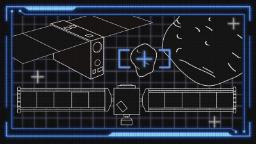
A NASA spacecraft will intentionally crash into an asteroid’s moon to see how it affects the motion of an asteroid in space. The Double Asteroid Redirection Test, or DART, is aiming to collide with Dimorphos on September 26 at 7:14 p.m. ET. Learn more about the spacecraft, its final destination and what we’ll see.
The Double Asteroid Redirection Test will be the first time that humanity has sent a spacecraft to measurably change the orbit of a celestial body. The mission will also be the world’s first full-scale demonstration of deflection technology that could protect the planet.
The DART spacecraft is heading for Dimorphos, a small moon orbiting the near-Earth asteroid Didymos. The asteroid system poses no threat to our planet, making it a perfect target to test out a kinetic impact — which may be needed if an object is ever on track to hit Earth.
The double-asteroid system is visible through ground-based telescopes as a single point of light, but DART will provide our first look — in exquisite detail — at Dimorphos. The mission will allow scientists to have a better understanding of the size and mass of each asteroid, which is crucial to our understanding of near-Earth objects.
Near-Earth objects are asteroids and comets with an orbit that places them within 30 million miles (48.3 million kilometers) of Earth. Detecting the threat of near-Earth objects that could cause grave harm is a primary focus of NASA and other space organizations around the world.
No asteroids are currently on a direct impact course with Earth, but more than 27,000 near-Earth asteroids exist in all shapes and sizes.
The valuable data collected by DART will contribute to planetary defense strategies, especially the understanding of what kind of force can shift the orbit of a near-Earth asteroid that could collide with our planet.
The DART vehicle launched aboard a Falcon 9 rocket in November 2021. With its large solar arrays, DART is about the size of a school bus. Its total mass will be roughly 1,260 pounds (570 kilograms) when it smacks into Dimorphos.
The spacecraft has two Roll-Out Solar Arrays, called ROSA. The flexible wings are lighter than traditional solar arrays, despite the fact that each one is 27.9 feet (8.5 meters) long. Solar cells and reflective concentrators within the arrays provide DART with three times more power than standard solar arrays on other spacecraft. These rollable arrays have been tested and installed outside of the International Space Station, but DART marks the first time NASA will use them on a planetary spacecraft.
Another first aboard DART is its Evolutionary Xenon Thruster—Commercial propulsion system, or NEXT-C. Testing this technology, which enhances fuel efficiency, on DART will help researchers assess how it performs for possible inclusion on future deep space missions. The solar-powered system relies on an ion drive that bombards xenon gas with electrically charged atoms.
The spacecraft will guide itself using the Small-body Maneuvering Autonomous Real Time Navigation, or SMART Nav system. This system syncs with DART’s eyes, the Didymos Reconnaissance and Asteroid Camera for Optical navigation, or DRACO, to allow the spacecraft to identify the double-asteroid system and distinguish which space object it’s supposed to impact.
What’s more, DRACO will serve as a high-resolution camera that can measure the size and shape of its target in order to determine where it will impact the asteroid’s moon — all while capturing stunning images of the two asteroids that will stream to Earth in real time at a rate of one image per second.
Acting as DART’s videographer is the Italian Space Agency’s Light Italian CubeSat for Imaging of Asteroids, or LICIACube. This briefcase-size CubeSat hitched a ride with DART to space and detached from the spacecraft on September 11.
On the CubeSat are two cameras called LUKE (LICIACube Unit Key Explorer) and LEIA (LICIACube Explorer Imaging for Asteroid). Together, they will collect images and help guide LICIACube on its journey. The little satellite travels behind DART to record what happens.
Astronomers discovered Didymos more than two decades ago. It means “twin” in Greek, a nod to how the asteroid forms a binary system with the smaller asteroid, or moon.
Didymos is roughly 2,560 feet (780 meters) across. Meanwhile, Dimorphos is 525 feet (160 meters) in diameter, and its name means “two forms.”
Dimorphos was chosen for this mission because its size is comparable to asteroids that could pose a threat to Earth. An asteroid the size of Dimorphos could cause “regional devastation” if it impacted Earth.
About four hours before the impact event on September 26, the spacecraft will become autonomous. At that time, DART will actually be targeting Didymos because it still won’t be able to see tiny Dimorphos yet. The spacecraft will still be 56,000 miles (90,000 kilometers) away from the asteroid.
About 50 minutes before impact, Dimorphos will come into view and DART will slightly transition its field of view to focus on the little moon. Slowly, Dimorphos will shift from being a tiny point of light and grow larger and larger within the frame of DRACO’s camera.
Scientists will be able to see the moonlet for the first time, determining its shape and structure and how rocky or smooth it is. Each image will reveal more detail as DART gets closer.
The SMART Nav system will guide DART until about two minutes prior to impact.
The spacecraft will accelerate to more than 13,421 miles per hour (21,600 kilometers per hour) when it collides with Dimorphos — effectively ending the DART mission.
The spacecraft is about 100 times smaller than Dimorphos, so it won’t obliterate the asteroid or blow it into pieces. Instead, DART will try to change the asteroid’s speed and path in space. The mission team has compared the spacecraft’s impact on the tiny asteroid to a golf cart crashing into one of the great pyramids — it will hit with enough energy to leave an impact crater.
Three minutes after impact, LICIACube will fly by Dimorphos to capture images and video of the ejecta cloud as it sprays up off the asteroid and maybe even spy the impact crater. The mini satellite will also glimpse Dimorphos’ opposite hemisphere, which DART won’t get to see before it’s obliterated. The CubeSat will turn to keep its cameras pointed at Dimorphos as it flies by.
The video, while not immediately available, will be streamed back to Earth in the weeks and months following the collision.
This kinetic impact is just one way to redirect asteroids that may pose a threat to Earth, but it’s the one scientists believe to be the “most technologically mature.”
The fast impact will only change Dimorphos’ speed as it orbits Didymos by 1%, which doesn’t sound like a lot — but it will change the moon’s orbital period.
The nudge will shift Dimorphos slightly and make it more gravitationally bound to Didymos — so the collision won’t change the binary system’s path around Earth or increase its chances of becoming a threat to our planet.
Dimorphos completes an orbit around Didymos every 11 hours and 55 minutes. After the impact, that may change between 73 seconds and 10 minutes. Follow-up observations will determine how much of a shift will have occurred.
Astronomers will use ground-based telescopes to observe the binary asteroid system and see how much the orbital period of Dimorphos changed, which will determine whether DART was successful. Scientists can compare observations prior to the impact with those taken after.
Telescopes around the world will observe Dimorphos as it passes in front of and behind the asteroid. Measuring the brightness of Didymos and how it changes can help astronomers determine how the orbital period has changed.
Space-based telescopes such as Hubble, Webb and NASA’s Lucy mission will also observe the event.
The first full-frame images from LICIACube will return and be processed a couple of days after the impact. The satellite’s unique perspective will provide a view of the impact and Dimorphos that scientists wouldn’t be able to see any other way.
To survey the aftermath of the impact, the European Space Agency’s Hera mission will launch in 2024. The spacecraft, along with two CubeSats, will arrive at the asteroid system in 2026, about four years after DART completes its mission. Once there, Hera will study both asteroids, measure physical properties of Dimorphos, and examine the DART impact crater and the moon’s orbit, continuing with the overall aim of establishing an effective planetary defense strategy.
Note:- (Not all news on the site expresses the point of view of the site, but we transmit this news automatically and translate it through programmatic technology on the site and not from a human editor. The content is auto-generated from a syndicated feed.))




I loved as much as you will receive carried out right here.
The sketch is attractive, your authored subject matter stylish.
nonetheless, you command get got an nervousness over that you wish be delivering the following.
unwell unquestionably come more formerly again as exactly the same nearly
very often inside case you shield this increase. https://OKE.Zone/profile.php?id=489442
Hi there! This article couldn’t be written any better!
Going through this article reminds me of my previous roommate!
He continually kept preaching about this. I’ll send this article
to him. Pretty sure he will have a great read. Thanks for sharing!
You’re so cool! I do not suppose I’ve read through a single thing like that before.
So great to find another person with a few original thoughts
on this subject matter. Seriously.. many thanks for starting
this up. This website is one thing that is required on the internet, someone with some
originality!